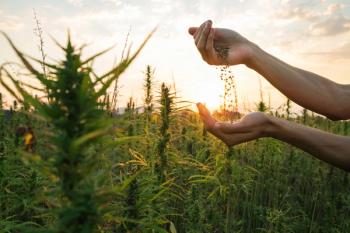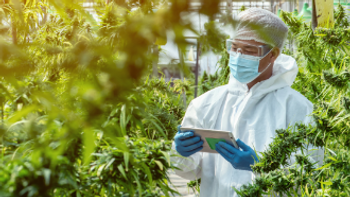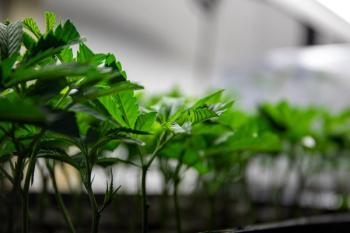
Vapor Pressure Deficit: Highlighting the Need to Maximize Cannabis Crops

The cannabis industry is evolving at a rapid rate. Growers are all looking for ways to produce the most profitable crops in an industry that lacks standardization and guidelines. One tool that has been beneficial in cannabis cultivation is vapor pressure deficit (VPD), which has been found to be very important for how nutrients are transported throughout the plant. Here, Hannia Mendoza-Dickey, University of Texas at El Paso, Department of Chemistry and Biochemistry; Robert Manes, Curtis Mathes Corporation; and Zacariah L. Hildenbrand, University of Texas at El Paso, Curtis Mathes Corporation, discuss the significance of VPD, why the cannabis industry is moving forward with this process, and a preview of their upcoming article titled “Intensity and Spectrum: The Role of Lighting in Vapor Pressure Deficit.”
Can you tell us a little bit about your upcoming article in Cannabis Science and Technology titled, “Intensity and Spectrum: The Role of Lighting in Vapor Pressure Deficit”?
Hannia Mendoza-Dickey, Robert Manes, and Zacariah L. Hildenbrand: Vapor pressure deficit (VPD) is crucial to moving water, CO2 and nutrients through a plant’s xylem and other vascular tissues in a process known as transpiration. There are several factors that contribute to vapor pressure deficit with lighting being one of the more influential variables. Lighting contributes directly in the form of heat production, which also influences humidity. Indirectly, lighting spectrum can affect stomatal opening, increasing or decreasing transpiration rates.
What is VPD? Why is it so important?
Mendoza-Dickey, Manes, and Hildenbrand: VPD is a differential between relative humidity and the saturation point (100% humidity) of the environment. The differential of humidity in the environment outside the plant, and that within the plant’s tissues drives movement of water, CO2 and nutrients throughout a plant’s vascular system. Think of the environment outside the plant as a low-pressure system and the environment inside the plant as a high-pressure system, with the plant always striving to create an equilibrium between the two. It is interesting to note that transpiration is a strong enough process to defy gravity, moving water and nutrients sometimes great vertical distances.
Maintaining an optimal VPD range is essential in cannabis cultivation as it directly influences plant growth, phytochemical content, and yield. Different stages of plant development necessitate specific VPD ranges to ensure ideal growth conditions. By carefully monitoring and controlling VPD, cultivators can establish a favorable environment that maximizes plant growth, yield, and overall health.
What is VPD influenced by?
Mendoza-Dickey, Manes, and Hildenbrand: VPD is influenced by several factors, with the most influential being temperature and humidity. Thermal sources, such as lighting and even leaves and tissues can alter VPD’s influence on a plant. The use of fans can speed evaporation by breaking vapor surface tension at the stomata. Personnel within the grow space can alter VPD through exhalation and body heat. There are many variables that can affect VPD within a horticultural space.
How important is lighting regarding VPD?
Mendoza-Dickey, Manes, and Hildenbrand: Lighting can directly and indirectly influence VPD. 100% of the energy used for lighting is not converted into light. Depending upon the lighting technology, the majority of the energy consumed is converted into waste heat. This source of heat greatly influences VPD. Indirectly, lighting frequency can cause stomatal openings to open or close. Open stomata release vapor pressure, which lowers leaf temperature therefore increasing vapor pressure differentials between the plant’s vascular system and the environment.
Is LED lighting the best option for VPD manipulation?
Mendoza-Dickey, Manes, and Hildenbrand: It can be and it is our opinion that it is. Surely, the lighting technology must be taken into account for VPD management. High intensity discharge (HID) lighting, such as high pressure sodium, metal halide, and ceramic metal halide fixtures are still the predominant lighting choice in controlled environment hemp and cannabis cultivation. These fixtures notably convert very little of their energy (~5–10%) consumption into light usable by plants. The rest is expelled as waste heat. Further, the output spectrum of HID lighting is usually lacking some key frequencies necessary for optimal plant growth and desirable phytochemical content production.
LED lighting converts much more of total energy consumption into usable light—up to 24–26%.Further, full-spectrum LED fixtures provide much more of the spectrum necessary for desirable plant health, transpiration and excitation of Chlorophyll A and Chlorophyll B photoreceptors that drive photosynthesis. One of the keys to any successful cultivation operation is efficient thermal management of this waste heat.
Also, the interplay between red and blue light wavelengths for instance, impacts stomatal openings/conductance, which in turn influences transpiration rates, and overall plant health. By adjusting the spectrum of LED lighting, cultivators can optimize VPD conditions for different growth stages.
Can you provide examples (or does your article discuss) of how you have successfully used lighting techniques to maintain optimal VPD and achieve better cannabis crop yields?
Mendoza-Dickey, Manes, and Hildenbrand: One technique is to increase power to frequencies specific to certain plant functions. This increases penetration of these “overpowered” frequencies to affect leaves and tissues below the plant’s upper canopy. Overdriving correct blue and red frequencies to reach more photoreceptors increases stomatal vapor release and transpiration and also reduces leaf temperatures.
Where do you see the cannabis industry going with VPD?
Mendoza-Dickey, Manes, and Hildenbrand: Believe it or not, one of the keys to producing great hemp and cannabis versus marginal hemp and cannabis is consistency. This pertains to environment, regimen, and sustenance (nutrients). Controlled environment agriculture (CEA) methods go a long way to provide for an efficient and consistent operation. Unfortunately, many of the cultivation control systems available do not take VPD into account. When VPD is too high, nutrients are wasted. Even higher and transpiration stops. Too low and transpiration is similarly low. Very often these conditions can occur in thermal variances of only a few degrees.
A real time cultivation management system that incorporates all environmental controls and takes VPD into account to manage those controls will ultimately produce higher-quality medicines in greater quantities with less room for error, reducing a cultivator’s cost of goods sold.
By leveraging such technologies, cultivators can not only achieve precise VPD management but also reduce costs and optimize resource efficiency in cultivation practices.
As more research and understating of VPD is done, there may be more tailored VPD recommendations for different strains and varietals. Cultivators will be able to access strain-specific VPD guidelines that consider the unique characteristics and requirements of individual cultivars, further optimizing plant growth and maximizing yields. Therefore, cultivators don’t have to struggle with trial and error anymore.
Why should cultivators be sure to read this article?
Mendoza-Dickey, Manes, and Hildenbrand: VPD is one of the primary variables in growing high-quality hemp and cannabis. Education and acquiring useful knowledge are the first steps towards a successful operation.
This article provides valuable information on what VPD is, how it is calculated, and its significance in cannabis cultivation. It highlights the importance of maintaining an optimal VPD range at different growth stages to promote healthy plant development, nutrient uptake, and resistance against common issues like mold or pests. By grasping the concept of VPD, cultivators can make informed decisions regarding environmental control to optimize growing conditions. Hopefully it empowers cultivators to create an environment conductive to healthy and thriving plants.
Newsletter
Unlock the latest breakthroughs in cannabis science—subscribe now to get expert insights, research, and industry updates delivered to your inbox.



